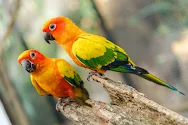Have you ever wondered how animals "talk" to each other without using words? From the deepest oceans to the highest mountain peaks, the animal kingdom is buzzing with incredible forms of communication. Animals use a surprising variety of signals to share information about food, danger, and even to find a mate. Get ready to discover some of the fascinating ways wildlife talks!Sounds: The Universal Language
Many animals use sound to communicate across distances and some of the animals and their sounds include:
Whales and Dolphins
These intelligent marine mammals use complex clicks, whistles, and songs to navigate, hunt, and socialize underwater. Some whale songs can travel thousands of miles! Birds
From melodic chirps to alarm calls, birds use a wide range of vocalizations to mark territory, warn of predators, and attract mates. Each song can carry specific messages.
Elephants
As we touched on before, elephants use low-frequency sounds (infrasound) that humans can't hear, allowing them to communicate with their herd members miles away through vibrations in the ground. Body Language: Speaking Without Words
Animals often express themselves through their posture, movements, and facial expressions. Let's look at the animals and their body expressions
Dogs
A wagging tail, flattened ears, or an aggressive stance all convey clear messages about a dog's mood and intentions. Wolves
Wolves use a complex system of body language, including tail position, ear movements, and facial expressions, to establish dominance, show submission, or indicate playfulness within their pack.
Chimpanzees
Our primate relatives use a wide array of facial expressions and gestures to show fear, happiness, aggression, or to invite grooming. Chemical Signals: The Scent of a Message
Pheromones are chemical signals released by animals that can convey messages to others of the same species. These signals include:
Ants
Ants leave pheromone trails to guide their colony members to food sources or to warn them of danger.
Moths
Female moths can release pheromones that attract males from miles away, guiding them directly to their location
Mammals
Many mammals use scent marking (urine, feces, or glands) to mark their territory, indicate reproductive status, or identify individuals. Visual Displays: A Show for Survival
Some animals use striking visual displays to attract mates or ward off rivals. Some of these animals include:
Peacocks
The male peacock's dazzling fan of feathers is a spectacular visual display used to attract a mate.
Fireflies
These tiny insects use synchronized flashes of light to find and communicate with potential partners in the dark.
Chameleons
Changes in a chameleon's skin color can signal mood, health, or readiness to mate.
Conclusion
The world of animal communication is incredibly rich and diverse, showing just how intelligent and social wildlife can be. From the songs of whales to the scent trails of ants, every creature has a unique way of sharing information. Understanding these fascinating behaviors helps us appreciate the intricate web of life on our planet.
What amazing animal communications have you observed? Share your thoughts and stories in the comments below! And be sure to check out our other posts on animal facts and stories!






.jpg)
.png)
.jpg)




%20(22).jpeg)
%20(20).jpeg)
A very educative content
ReplyDelete